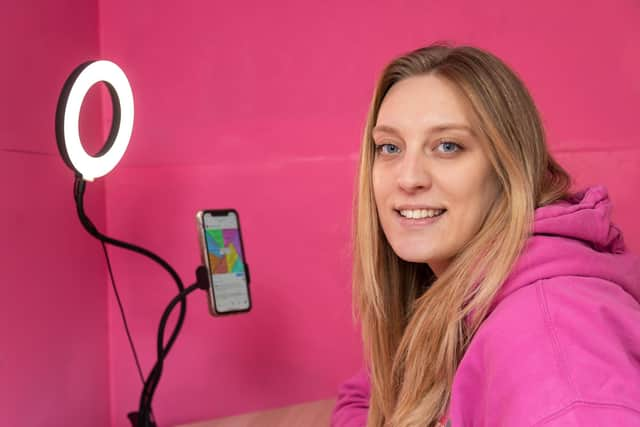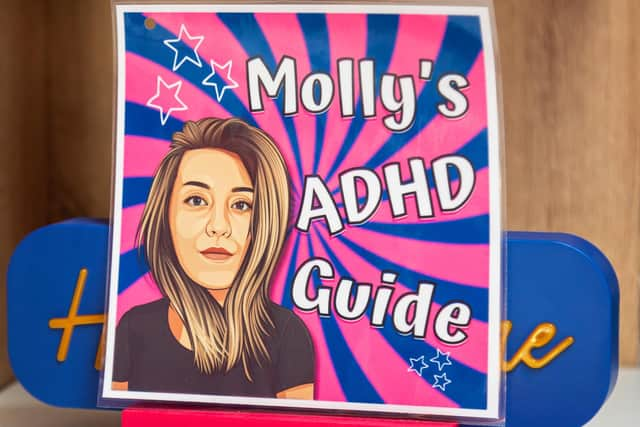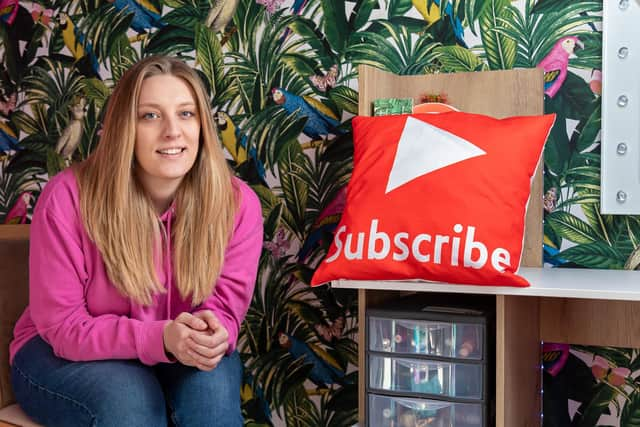Havant ADHD social media influencer goes from having zero friends to 58,000
and live on Freeview channel 276
School was traumatic. And no matter how hard Molly tried to fit in with her peers, she just couldn’t express herself in the same way as a non-autistic child.
Instead, she’d misbehave to the point where she’d find herself on report cards day in, day out for not paying attention – as she simply could not concentrate.
Advertisement
Hide AdAdvertisement
Hide AdIt didn’t take long for her to be labelled the ‘naughty child’ by staff and fellow pupils.


‘I was always in detention and teachers would say, “why don’t you learn from your mistakes?”
‘I tried my hardest to get myself in a friendship group. But I couldn’t fit in anywhere. I’ve always had issues with being able to verbally communicate how I’m feeling, so I’ve used behaviour as a way to express my emotions’, says the 23-year-old from Havant.
Eventually, when Molly got to year 10 – s he was excluded and placed in a part-time pupil referral unit as her behaviour spiralled out of control and her school could no longer accommodate her needs.
Advertisement
Hide AdAdvertisement
Hide AdAnd her suffering didn’t end there. After signing up to a public services course to achieve a lifelong dream of being a policewoman, Molly was told by a staff member that they ‘shouldn’t have to deal with her childish behaviour’, and that’s when in 2019 she paid to see a doctor - who confirmed Molly had a hyperactivity disorder called ADHD.


SEE MORE: Children in Portsmouth and Hampshire 'suffering' with long waits for CAMHS mental health treatment
‘The doctor said “how have you got this far through life and not known about your ADHD?”
‘I was told I had the severe combined type (where both inattention and impulsivity are present).
Advertisement
Hide AdAdvertisement
Hide AdMolly also has ASD, an autism spectrum disorder, associated with her ADHD.


‘I’m now medicated with amphetamines – a drug which improves focus and reduces impulsivity - and that helps me daily.’
On the medication, Molly can control her impulses – along with coping mechanisms to ease symptoms. But she can still have meltdowns when she can’t disconnect from reality while sucked in by an obsession, known as hyper-fixation.
Even when Molly finally had the peace of mind about what had caused her behavioural outbursts, she fast saw her dreams come crashing down.
Advertisement
Hide AdAdvertisement
Hide AdShe explains: ‘I went through this stage of not knowing who I was or where I wanted to be. It almost made me feel like that was it, my life was ruined.
‘Now I can see why I struggled academically. Not because I wasn't bright, but because I couldn't sit down and read so I didn't ever thrive in school. I was always put down to be a bit of a failure just because my ADHD was undiagnosed.’
However, soon after the diagnosis, isolated and alone with her condition, Molly took a leap of faith and fired up a blog.
First, it was just so her mum could understand how she felt as somebody under the autism umbrella. But within a couple of weeks, her Facebook blog, ‘Me, Myself and ADHD’ had amassed more than 5,000 followers.
Advertisement
Hide AdAdvertisement
Hide AdToday Molly’s social media boasts 58,000 followers on Facebook, Instagram, Twitter and YouTube, and now her platform acts as a voice to the many who feel silenced thanks to a lack of understanding about the condition.
‘I only started it on impulse. I thought I want to get across how I feel. I only thought my mum was going to follow it but I soon had 15,000 followers on Facebook. A lot of them are parents who have kids who are younger and they’ve gone through everything I went through.
‘I’ve had parents say, “you’ve given me an insight into how my child feels”, and I thought although I am being that friend, that big sister that I never had, I really needed this community and it's really helped me.’
‘I get so many messages every day like, "You've saved mine and my daughter's relationship because you've given her a voice”.
Advertisement
Hide AdAdvertisement
Hide Ad‘I feel I've achieved everything I ever wanted to achieve within the six months of starting this whole journey on Instagram and Facebook.’
Molly, who sells hand-made mugs and ADHD positivity stickers on her Etsy shop, Sticky Traits, discovered through learning more about her own symptoms, she could give out tips on managing them and the ‘embarrassing’ taboo topics Molly says people tend to shy away from.
‘I speak about some of the things for neurotypical people to understand, who don't have ADHD. I've spoken about not being able to brush your teeth, struggling to maintain hygiene levels, and how ADHD can affect your sex life.
‘That's one of my most viewed YouTube videos.
‘It's an embarrassing topic but when you have ADHD and you don't have a parent with it, or a sibling or a friend - you have these questions in your head like "is this normal"? Molly also has her own book, Me, Myself and ADHD.
Advertisement
Hide AdAdvertisement
Hide Ad‘To me, every single person in my online community is my friend.
‘I've given back to that little Molly when I was younger, when I felt so alone, and so scared and so different. I've given myself that reassurance. I'm giving back to that little Molly who had nothing.’
Why is ADHD often missed in girls?
Molly Brooks-Dridge speaks out on how Attention Deficit Hyperactivity Disorder can be missed in females.
‘Many more boys get diagnosed with ADHD than girls.
‘When I went to my private doctor he said a lot of females go into their adulthood undiagnosed because it's easier for females to cope than it is for males.
Advertisement
Hide AdAdvertisement
Hide Ad‘We can internalise our ADHD and it looks like it's anxiety or depression because we suppress it so much. ‘When I went to the doctor, and I went multiple times, I was given sertraline anti-depressants but it never helped. Never.
‘That wasn't the reason for my behaviour. It's definitely still stigmatised as a boy condition.
‘All the things like paying attention, concentrating, are things people don't realise is based on an ability of the brain to control the emotional regulation. We can't regulate our behaviour. So we internalise it.
‘There's a thing people with ADHD and autism may do called masking. ‘When you haven't got the correct diagnosis or help you naturally to try to copy and paste your environment so you learn to cope.
Advertisement
Hide AdAdvertisement
Hide Ad‘That's how girls suffering can go undiagnosed because they learn to hide it. It can be misinterpreted as naughty behaviour.’
A message from the Editor, Mark Waldron
You can subscribe here for unlimited access to our online coverage, including Pompey, with 70 per cent fewer adverts for less than 20p a day.
Comment Guidelines
National World encourages reader discussion on our stories. User feedback, insights and back-and-forth exchanges add a rich layer of context to reporting. Please review our Community Guidelines before commenting.
